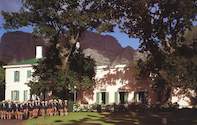Restructuring SACS

In the 1930s the prefect system that had ruled in the boys' boarding houses at SACS was extended to the school itself and the first competitive and administrative house system developed. SACS's first head prefect, Harold A van Hoogstraten, went on to become appropriately enough, member of parliament for the Gardens constituency in 1970. The Old Boys' Union bought five acres of land in Oranjezicht,for school playing fields and a pavilion.
But the problem with SACS was that it was on the move — literally. It's hostels and classrooms sprawled over a large area; when the weather was bad, taxis were hired to ferry the boys through the rain. Sports fields and facilities were similarly distanced from the school itself.
At the end of the Second World War a new guard of staff, pupils and Old Boys was pressing not just for the refurbishing and reorganising of SACS but for a completely new and modern seat of learning.
By the mid-1950s the efforts of crusaders such as headmaster Robin Whiteford, Norman Henshilwood, a member of the Cape Executive Council (both SACS Old Boys), and teacher E Spencer Smith, who had been at SACS for 20 years, had been rewarded. Their petitions to the province for the school to be moved to another, comprehensive, site were finally successful. Montebello, an estate in Newlands belonging to the Michaelis family, was acquired as a new school site.
Michaelis House
The homestead, called Michaelis House at the time — and, serving as one of the high-school residences, still known by that name today — could boast a colourful and gracious past. The Newlands estate was originally part of a farm known as Papenboom, with its own vineyards and brewery. When the homestead was badly damaged by fire in the mid- 1700s, the architect-builder Thibault was commissioned to erect another home that was to be known as Montebello.
In 1882 Anders Ohlsson officially started a brewery again on the estate and added a conservatory and music room/dance hall to the main house. After Ohlsson's death in 1912, Maximilian Michaelis bought Montebello and contracted with architect JM Solomon to effect alterations and additions to the house. After the death of Michaelis in 1953 his widow gave the home to SACS. Spencer Smith established the first high-school presence at Montebello in 1954 with 35 boarders in Michaelis House — and, until the SACS family was able to reunite under one roof six years later, the boys took the bus to school in the Gardens.
The high-school buildings, designed by Captain LE Elsworth, that today stand on the Newlands property were not finished and occupied until 1960. From that day Rosedale, De Villiers and Michaelis houses have flourished under the pines and magnolias of the splendid 44-acre estate and in the 1990s became home to learners regardless of their colour.
Headmaster GM Law arrived at SACS in 1984. During his tenure SACS did on its laurels: the development fund, launched in 1988, resulted in the building of the Old Boys' sports pavilion, offices for senior staff, and the purchase of computer and audiovisual equipment for teaching. In addition, a cricket pavilion named in honour of Robin Whiteford, headmaster from 1950 to 1972 and a rowing boathouse have been built. The Department of Education has
provided a music block and has footed the bill for the extensive renovations done on Michaelis House hostel.
In 1991, when renovations began on the grand old building, which still retains the Georgian character given it by Solomon, much of the stonework, archways, brass fittings and murals of bygone times were uncovered and, largely restored to its former glory, Michaelis House now stands proudly as SACS's historic flagship on Newlands Avenue.